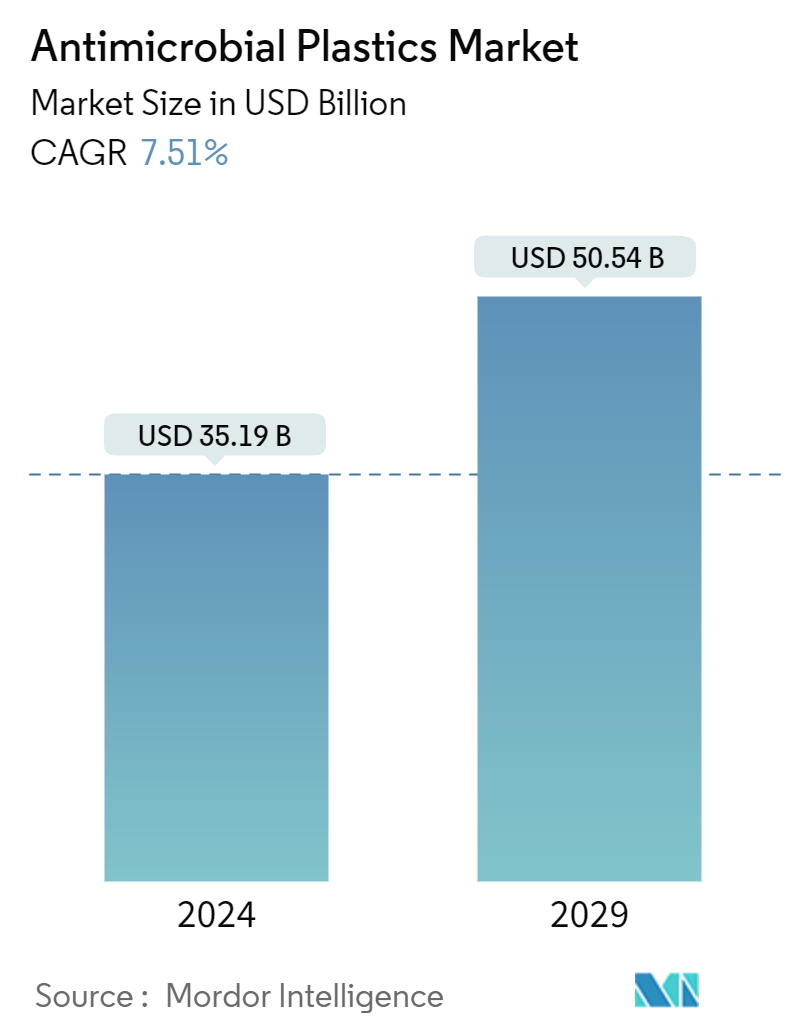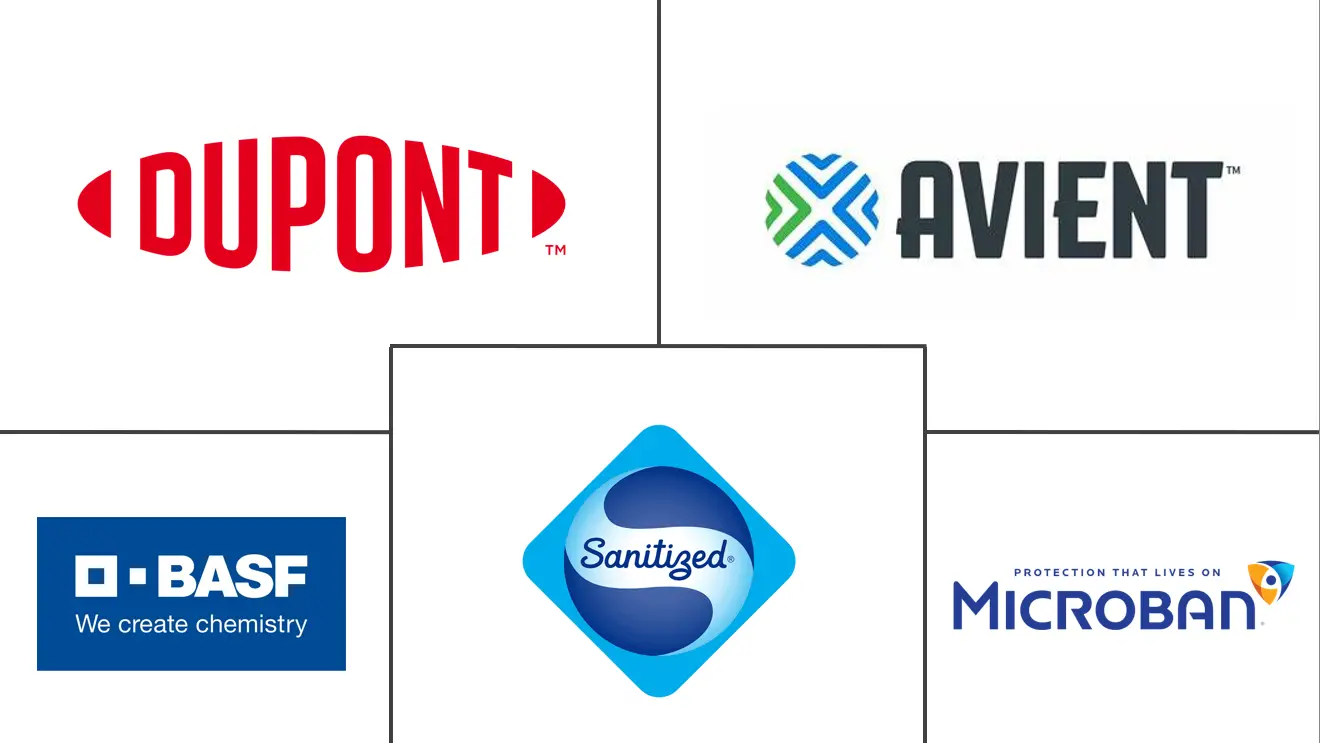Market Size of Antimicrobial Plastics Industry

| Study Period | 2019 - 2029 |
| Market Size (2024) | USD 35.19 Billion |
| Market Size (2029) | USD 50.54 Billion |
| CAGR (2024 - 2029) | 7.51 % |
| Fastest Growing Market | Asia Pacific |
| Largest Market | Asia Pacific |
| Market Concentration | Low |
Major Players
*Disclaimer: Major Players sorted in no particular order |
Antimicrobial Plastics Market Analysis
The Antimicrobial Plastics Market size is estimated at USD 35.19 billion in 2024, and is expected to reach USD 50.54 billion by 2029, growing at a CAGR of 7.51% during the forecast period (2024-2029).
The antimicrobial plastics market is gaining significant traction due to the rising demand for safer, more hygienic materials across various industries. These plastics, enhanced with antimicrobial additives , provide superior protection against microbial contamination. As sectors like healthcare, food packaging, and consumer goods increasingly prioritize hygiene and safety, the relevance and application of antimicrobial plastics are expanding rapidly, with the market poised for significant growth.
Growth Drivers in the Antimicrobial Plastics Market
- Material Substitution: The shift from conventional materials to antimicrobial plastics is a key growth driver. These plastics offer a combination of durability and the ability to inhibit the growth of harmful microorganisms, making them a preferred choice across industries. This trend is expected to continue as hygiene concerns grow globally, particularly in the wake of recent health crises, boosting the demand for antimicrobial plastic products.
- Healthcare and Packaging Demand: The healthcare and packaging industries are driving demand for antimicrobial plastics. In healthcare, these materials are crucial for reducing infection risks in medical devices, equipment, and surfaces. Similarly, in the packaging industry, especially for food and beverages, antimicrobial plastics help extend shelf life and maintain product safety. This demand is bolstered by increasing consumer awareness and the regulatory push for safer packaging solutions.
Challenges and Opportunities
- Environmental Regulations: Stringent environmental regulations pose a significant challenge to the antimicrobial plastics market. The production and disposal of these plastics are under scrutiny due to their environmental impact. Manufacturers are compelled to innovate, developing sustainable antimicrobial plastic solutions that comply with rigorous environmental standards. This challenge is particularly pronounced in regions with stringent regulations, where compliance can influence market dynamics.
- Raw Material Price Volatility: The antimicrobial plastics market faces the challenge of fluctuating raw material prices. These fluctuations, driven by supply chain disruptions, geopolitical tensions, and global demand shifts, can increase production costs and impact pricing strategies. This volatility introduces pricing pressures that could affect market growth and profitability, making it a critical factor for industry stakeholders to manage.
Antimicrobial Plastics Industry Segmentation
Antimicrobial Plastics are polymers infused with agents capable of eradicating or restraining the proliferation of microorganisms like bacteria, viruses, and fungi. These antimicrobial compounds are typically incorporated into the plastic during its manufacturing, allowing for tailor-made and enduring antimicrobial defense. Such plastics find widespread use across diverse sectors, including medical devices, food packaging, and water treatment systems.
Type, end-user industry, and geography segment the antimicrobial plastics market. By type, the market is segmented into commodity plastic, engineering plastic, high-performance plastic, and other types (bioplastics, etc.). By end-user industry, the market is segmented into packaging, healthcare, consumer goods, electrical and electronics, automotive, building and construction, food and beverage, and others (textile, etc.). The report also covers the market size and forecasts for the antimicrobial plastics market in 15 countries across major regions. Each segment's market sizing and forecasts are provided on the basis of value (USD).
| Type | |
| Commodity Plastic | |
| Engineering Plastic | |
| High Performance Plastic | |
| Other Types (Bioplastics, etc.) |
| End-User Industry | |
| Automotive | |
| Building and Construction | |
| Consumer Goods | |
| Electrical and Electronics | |
| Food and Beverage | |
| Healthcare | |
| Packaging | |
| Other End-user Industries (Textile, etc.) |
| Geography | |||||||
| |||||||
| |||||||
| |||||||
| |||||||
|
Antimicrobial Plastics Market Size Summary
The antimicrobial plastics market is poised for significant growth, driven by the increasing replacement of conventional materials with antimicrobial alternatives across various sectors. The healthcare and packaging industries are the primary drivers of this market expansion, with antimicrobial plastics offering enhanced cleanliness and sterility, which are crucial in medical settings. The demand for these materials is further bolstered by the need to combat healthcare-associated infections and microbial contamination. Despite the promising growth trajectory, the market faces challenges from stringent environmental regulations concerning plastic usage and disposal. However, ongoing investments in research and development, along with rising healthcare expenditures, present substantial opportunities for market players.
The Asia-Pacific region is expected to lead the market's growth, fueled by the burgeoning packaging industry and rising demand from sectors such as consumer goods, food and beverages, and automotive. Countries like China and India are at the forefront of this expansion, with significant investments in healthcare infrastructure and packaging innovations. The region's rapid industrialization and increasing production capacities are set to drive the demand for antimicrobial plastics. Additionally, the automotive industry's growth and the need for cleaner vehicle interiors further contribute to the market's expansion. Key players in the market, including BASF SE, DuPont, and Microban International, are actively developing new technologies to enhance the properties and applications of antimicrobial plastics, ensuring sustained growth during the forecast period.
Antimicrobial Plastics Market Size - Table of Contents
-
1. MARKET DYNAMICS
-
1.1 Drivers
-
1.1.1 Replacement of Conventional Materials by Plastics in Various Applications
-
1.1.2 Rapidly Increasing Demand from the Healthcare and Packaging Industries
-
1.1.3 Growing Consciousness of Antimicrobial Plastics
-
-
1.2 Restraints
-
1.2.1 Stringent Environmental Regulations
-
1.2.2 Erratic Fluctuations in Raw Material Prices
-
-
1.3 Industry Value Chain Analysis
-
1.4 Porter's Five Forces Analysis
-
1.4.1 Bargaining Power of Suppliers
-
1.4.2 Bargaining Power of Buyers
-
1.4.3 Threat of New Entrants
-
1.4.4 Threat of Substitute Products and Services
-
1.4.5 Degree of Competition
-
-
-
2. MARKET SEGMENTATION (Market Size in Value)
-
2.1 Type
-
2.1.1 Commodity Plastic
-
2.1.2 Engineering Plastic
-
2.1.3 High Performance Plastic
-
2.1.4 Other Types (Bioplastics, etc.)
-
-
2.2 End-User Industry
-
2.2.1 Automotive
-
2.2.2 Building and Construction
-
2.2.3 Consumer Goods
-
2.2.4 Electrical and Electronics
-
2.2.5 Food and Beverage
-
2.2.6 Healthcare
-
2.2.7 Packaging
-
2.2.8 Other End-user Industries (Textile, etc.)
-
-
2.3 Geography
-
2.3.1 Asia-Pacific
-
2.3.1.1 China
-
2.3.1.2 India
-
2.3.1.3 Japan
-
2.3.1.4 South Korea
-
2.3.1.5 Rest of Asia-Pacific
-
-
2.3.2 North America
-
2.3.2.1 United States
-
2.3.2.2 Canada
-
2.3.2.3 Mexico
-
-
2.3.3 Europe
-
2.3.3.1 Germany
-
2.3.3.2 United Kingdom
-
2.3.3.3 France
-
2.3.3.4 Italy
-
2.3.3.5 Rest of Europe
-
-
2.3.4 South America
-
2.3.4.1 Brazil
-
2.3.4.2 Argentina
-
2.3.4.3 Rest of South America
-
-
2.3.5 Middle East and Africa
-
2.3.5.1 Saudi Arabia
-
2.3.5.2 South Africa
-
2.3.5.3 Rest of Middle East and Africa
-
-
-
Antimicrobial Plastics Market Size FAQs
How big is the Antimicrobial Plastics Market?
The Antimicrobial Plastics Market size is expected to reach USD 35.19 billion in 2024 and grow at a CAGR of 7.51% to reach USD 50.54 billion by 2029.
What is the current Antimicrobial Plastics Market size?
In 2024, the Antimicrobial Plastics Market size is expected to reach USD 35.19 billion.

